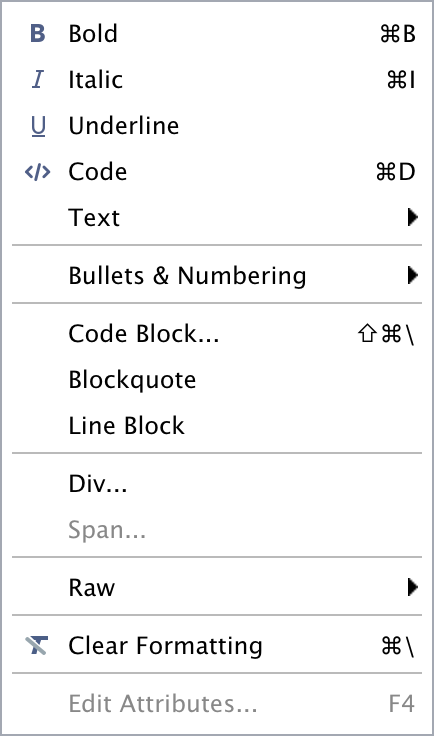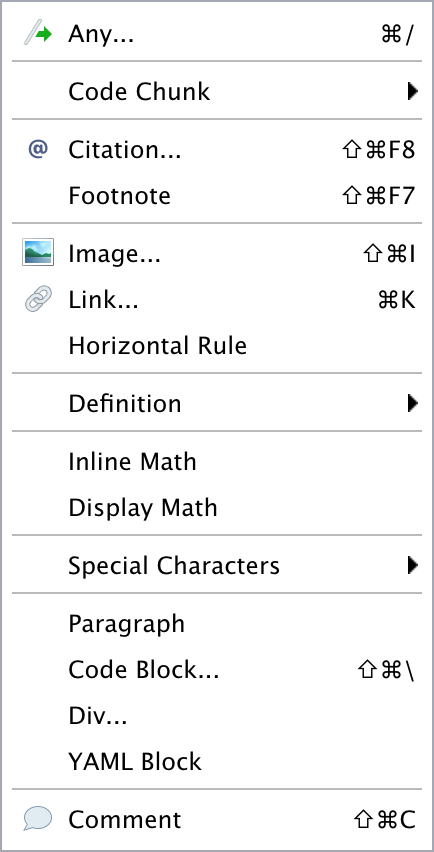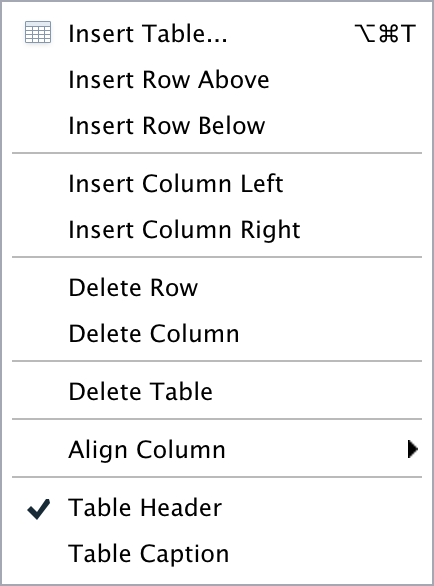Usage: quarto
Version: 1.4.549
Description:
quarto CLI
Options:
-h, --help - Show this help.
-V, --version - Show the version number for this program.
Commands:
render [input] [args...] - Render files or projects to various document types.
preview [file] [args...] - Render and preview a document or website project.
serve [input] - Serve a Shiny interactive document.
create [type] [commands...] - Create a `Quarto` project or extension
use <type> [target] - Automate document or project setup tasks.
add <extension> - Add an extension to this folder or project
update [target...] - Updates an extension or global dependency.
remove [target...] - Removes an extension.
convert <input> - Convert documents to alternate representations.
pandoc [args...] - Run the version of Pandoc embedded within `Quarto`.
typst [args...] - Run the version of Typst embedded within `Quarto`.
run [script] [args...] - Run a TypeScript, R, Python, or Lua script.
install [target...] - Installs a global dependency (TinyTex or Chromium).
uninstall [tool] - Removes an extension.
tools - Display the status of `Quarto` installed dependencies
publish [provider] [path] - Publish a document or project to a provider.
check [target] - Verify correct functioning of `Quarto` installation.
help [command] - Show this help or the help of a sub-command. What is Quarto ?
Literate programming
Quarto implements the concept of literate programming.
Literate programming is a programming paradigm introduced in 1984 by Donald Knuth in which a computer program is given as an explanation of how it works in a natural language, such as English, interspersed (embedded) with snippets of macros and traditional source code, from which compilable source code can be generated.
Initial concept

Modern implementation with Quarto

Multiple outputs
Quartoprovides a unified authoring framework for data science, combining your code, its results, and your prose.
Quartodocuments are fully reproducible, they automate the inclusion of the last versions of the results of an analysis, literally dozens of output formats are available: Web pages, PDFs, Word files, websites, books, and more.

Relevant to many use cases
According to Hadley Wickham Quarto files are designed to be used in three ways:
- For communicating to decision-makers or to a more general audience, who want to focus on the conclusions, not the code behind the analysis.
- For collaborating with other data scientists (including future you!), who are interested in both your conclusions, and how you reached them (i.e. the code).
- As an environment in which to do data science, as a modern-day lab notebook where you can capture not only what you did, but also what you were thinking. Recall Galileo and his notebook.

Tailored to modern data science
Quarto is a language agnostic command line interface (CLI)
The machinery

Meet Quarto
Authoring Quarto documents
When working with R using Rstudio, Quarto comes pre-installed with recent versions of Rstudio.
To create a new document in RStudio, go to File > New File > Quarto Document:

Authoring Quarto documents
When working with R using Positron, Quarto comes pre-installed with Positron.
To create a new document in Positron, go to File > New File > Quarto Document:

Authoring Quarto documents
Source editor

Authoring Quarto documents

Authoring Quarto documents
Back to source …

Authoring Quarto documents
Use the Render button in the RStudio IDE to render the file and preview the output with a single click or keyboard shortcut (⌘ / ctrl ⇧K).

Automatically render on save by checking the Render on Save option:

Quarto files can also be rendered programmatically using the quarto command line:
or with the quarto R package:
Anatomy of a qmd file
It contains three types of content:
- An (optional) YAML header surrounded by —s.
- Text mixed with simple text formatting like ## heading, bolds and italics.
- Chunks of R code surrounded by ```{r}.
---
title: "Hello, Penguins"
format: html
execute:
echo: false
---
## Meet the penguins
The __penguins__ data contains size measurements for
penguins from three islands in the Palmer Archipelago,
Antarctica.
The _three_ species of penguins have quite distinct
distributions of physical dimensions (@fig-penguins).
#| label: fig-penguins
#| fig-cap: "Dimensions of penguins across three species."
#| warning: false
library(tidyverse, quietly = TRUE)
library(palmerpenguins)
penguins |>
ggplot(aes(x = flipper_length_mm, y = bill_length_mm)) +
geom_point(aes(color = species)) +
scale_color_manual(
values = c("darkorange", "purple", "cyan4")) +
theme_minimal()
YAML header
YAML header
The YAML header is demarcated by three dashes (—) on either end. It informs on some documents meta-data and sets up many generic and output format specific options. The YAML consists of key: values pairs. The colon and space are required.
YAML header can be very simple
YAML header
The YAML header is demarcated by three dashes (—) on either end. It informs on some documents meta-data and sets up many generic and output format specific options. The YAML consists of key: values pairs. The colon and space are required.
As well as much more elaborated, e.g. when scholarly writing
---
title: "Toward a Unified Theory of High-Energy Metaphysics: Silly String Theory"
date: 2008-02-29
author:
- name: Josiah Carberry
id: jc
orcid: 0000-0002-1825-0097
email: josiah@psychoceramics.org
affiliation:
- name: Brown University
city: Providence
state: RI
url: www.brown.edu
abstract: >
The characteristic theme of the works of Stone is
the bridge between culture and society. ...
keywords:
- Metaphysics
- String Theory
license: "CC BY"
copyright:
holder: Josiah Carberry
year: 2008
citation:
container-title: Journal of Psychoceramics
volume: 1
issue: 1
doi: 10.5555/12345678
funding: "The author received no specific funding for this work."
---YAML header
YAML headers can operate at the document level to manage execute options:
YAML header
All format specific options are listed in the Quarto official documentation.
YAML Intelligence: YAML code completion is available for project files, YAML front matter, and executable cell options:

If you have incorrect YAML it will also be highlighted when documents are saved:

Markdown
Markdown
Quarto is based on Pandoc and uses its variation of markdown as its underlying document syntax. Pandoc markdown is an extended and slightly revised version of John Gruber’s Markdown syntax.
Markdown is a plain text format that is designed to be easy to write, and, even more importantly, easy to read:
A Markdown-formatted document should be publishable as-is, as plain text, without looking like it’s been marked up with tags or formatting instructions. – John Gruber
The following two slides provide examples of the most basic markdown syntax. See the Quarto official website for more in-depth documentation.
Markdown
### Text formatting
*italic* **bold** ~~strikeout~~ `code`
superscript^2^ subscript~2~
[underline]{.underline} [small caps]{.smallcaps}
### Lists
- Bulleted list item 1
- Item 2
- Item 2a
- Item 2b
1. Numbered list item 1
2. Item 2.
The numbers are incremented automatically in the output.
### Equations
inline math: $E = mc^{2}$Text formatting
italic bold strikeout code
superscript2 subscript2
underline small caps
Lists
Bulleted list item 1
Item 2
Item 2a
Item 2b
Numbered list item 1
Item 2.
The numbers are incremented automatically in the output.
Equations
inline math: \(E = mc^{2}\)
Markdown
### Links and images
<https://rdatatoolbox.github.io/chapters/course-compendium.html>
[rdatatoolbox is there](https://rdatatoolbox.github.io/)
{fig-alt="rdatatoolbox logo" width="20%"}
### Tables
| First Header | Second Header |
|--------------|---------------|
| Content Cell | Content Cell |
| Content Cell | Content Cell |Links and images
https://rdatatoolbox.github.io/chapters/course-compendium.html

Tables
| First Header | Second Header |
|---|---|
| Content Cell | Content Cell |
| Content Cell | Content Cell |
Markdown
Rstudio’s visual editor toolbar includes buttons for the most commonly used formatting commands:

Markdown
Additional commands are available on the Format, Insert, and Table menus:
| Format | Insert | Table |
|---|---|---|
 |
 |
 |
Markdown
Rstudio’s visual editor toolbar includes buttons for the most commonly used formatting commands:

Check out the Quarto official documentation to learn more about visual markdown editing:
Technical Writing covers features commonly used in scientific and technical writing, including citations, cross-references, footnotes, equations, embedded code, and LaTeX.
Content Editing provides more depth on visual editor support for tables, lists, pandoc attributes, CSS styles, comments, symbols/emojis, etc.
Shortcuts & Options documents the two types of shortcuts you can use with the editor: standard keyboard shortcuts and markdown shortcuts and describes various options for configuring the editor.
Markdown Output describes how the visual editor parses and writes markdown and describes various ways you can customize this.
A complete guide to Quarto authoring is available in the official documentation.
Computations
Computations (using R)
Code blocks that use braces around the language name (e.g. ```{r}) are executable, and will be run by Quarto during render. Chunk options (optional), in YAML style, identified by #| at the beginning of the line are used to set chunk-specific meta-data and behaviours.
Going back to the penguins example:
---
title: "Hello, Penguins"
format: html
execute:
echo: false
---
## Meet the penguins
The __penguins__ data contains size measurements for
penguins from three islands in the Palmer Archipelago,
Antarctica.
The _three_ species of penguins have quite distinct
distributions of physical dimensions (@fig-penguins).
````{r}
#| label: fig-penguins
#| fig-cap: "Dimensions of penguins across three species."
#| warning: false
library(tidyverse, quietly = TRUE)
library(palmerpenguins)
penguins |>
ggplot(aes(x = flipper_length_mm, y = bill_length_mm)) +
geom_point(aes(color = species)) +
scale_color_manual(
values = c("darkorange", "purple", "cyan4")) +
theme_minimal()
````Computations (using R)
Code blocks that use braces around the language name (e.g. ```{r}) are executable, and will be run by Quarto during render. Chunk options (optional), in YAML style, identified by #| at the beginning of the line are used to set chunk-specific meta-data and behaviours.
Going back to the penguins example:
The _three_ species of penguins have quite distinct
distributions of physical dimensions (@fig-penguins).
````{r}
#| label: fig-penguins
#| fig-cap: "Dimensions of penguins across three species."
#| warning: false
library(tidyverse, quietly = TRUE)
library(palmerpenguins)
penguins |>
ggplot(aes(x = flipper_length_mm, y = bill_length_mm)) +
geom_point(aes(color = species)) +
scale_color_manual(
values = c("darkorange", "purple", "cyan4")) +
theme_minimal()
````
- A chunk label (“fig-penguins”) has been defined, it allows referencing (and auto-numbering) the plot produced by the code as a figure anywhere in the text (
@fig-penguins).
- A figure caption has been defined and is used in the rendered output.
- Warnings have been disabled and are discarded from the rendered output.

Computations (using R)


In addition to rendering the complete document to view the results of code chunks you can also run each code chunk interactively in the RStudio editor by clicking the icon or keyboard shortcut (Cmd/Ctrl + Shift + Enter).
RStudio executes the code and displays the results either inline within your file or in the Console, depending on your preference.
Computations (figures)
Multiple Figures: Put two plots side by side:
Computations (figures)
Put two plots side by side:

Computations (figures)
More complex layouts:
#| label: fig-complex
#| layout: [[30, 70], [100]]
#| fig-cap: multiple aspects of penguins
#| fig-subcap:
#| - "scatter plot"
#| - "flipper length"
#| - "boday mass"
ggplot(penguins,
aes(x = flipper_length_mm, y = bill_length_mm)) +
geom_point(aes(color = species, shape = species))
ggplot(data = penguins, aes(x = flipper_length_mm)) +
geom_histogram(aes(fill = species),
alpha = 0.5,
position = "identity")
ggplot(data = penguins, aes(x = body_mass_g)) +
geom_histogram(aes(fill = species),
alpha = 0.5,
position = "identity")Computations (figures)
More complex layouts:

Quarto for reproducible research
Cross references / Citations / Projects
Cross references
Quarto cross references provide automatic numbering and reference creation for figures, tables, equations, sections, listings, theorems, and proofs. In books, cross references work the same way except they can reach across chapters.
You can cross reference almost everything : figures, tables, equations, sections, …
Cross reference identifiers
To reference an item later we need an identifier for it.
Identifiers must start with the type of the item:
figures: fig-
tables: tbl-
equations: eq-
section: sec-
Check reserved/appropriate prefixes at the official documentation.
Cross references (non computational content)
Figures: To create a cross-referenceable figure and then refer to it:
Or, using divs :
Cross references (non computational content)
Tables
For markdown tables, add a caption below the table, then include a #tbl- label in braces at the end of the caption. For example:
Or using the div syntax:
Cross references (non computational content)
Sub-tables
::: {#tbl-panel layout-ncol=2}
| Col1 | Col2 | Col3 |
|------|------|------|
| A | B | C |
| E | F | G |
| A | G | G |
: First Table {#tbl-first}
| Col1 | Col2 | Col3 |
|------|------|------|
| A | B | C |
| E | F | G |
| A | G | G |
: Second Table {#tbl-second}
Main Caption
:::
See @tbl-panel for details, especially @tbl-second.
Cross references (non computational content)
Equations
Provide an #eq- label immediately after an equation to make it referenceable. For example:
Black-Scholes (@eq-black-scholes) is a mathematical model that seeks to explain the behavior of financial derivatives, most commonly options:
$$
\frac{\partial \mathrm C}{ \partial \mathrm t } + \frac{1}{2}\sigma^{2} \mathrm S^{2}
\frac{\partial^{2} \mathrm C}{\partial \mathrm S^2}
+ \mathrm r \mathrm S \frac{\partial \mathrm C}{\partial \mathrm S}\ =
\mathrm r \mathrm C
$$ {#eq-black-scholes}
Black-Scholes (Equation 1) is a mathematical model that seeks to explain the behavior of financial derivatives, most commonly options:
\[ \frac{\partial \mathrm C}{ \partial \mathrm t } + \frac{1}{2}\sigma^{2} \mathrm S^{2} \frac{\partial^{2} \mathrm C}{\partial \mathrm S^2} + \mathrm r \mathrm S \frac{\partial \mathrm C}{\partial \mathrm S}\ = \mathrm r \mathrm C \qquad(1)\]
Cross references (computations)
Figures:
Cross references (computations)
Tables:
Cross references (computations)
Sub-tables:

As always, check the official documentation.
Citations
Quarto uses Pandoc to automatically format in text citations and create a reference list properly styled. You’ll need:
A quarto document formatted with citations (see next slide).
A bibliographic data source, for example a BibLaTeX (.bib) or BibTeX (.bibtex) file. This can be automatically generated when using the visual
Quartoeditor.Optionally, a CSL file which specifies the formatting to use when generating the citations and bibliography.
Citations
Quarto uses the standard Pandoc markdown representation for citations (e.g. [@citation]) — citations go inside square brackets and are separated by semicolons. Each citation must have a key, composed of ‘@’ + the citation identifier from the database.
Here are some examples:
| Markdown Format | Output (default) | Output(csl: diabetologia.csl) | |
|---|---|---|
|
Blah Blah [see @knuth1984, pp. 33-35; also @wickham2015, chap. 1] | Blah Blah see [1], pp. 33-35; also [1], chap. 1 |
|
Blah Blah [@knuth1984, pp. 33-35, 38-39 and passim] | Blah Blah [1], pp. 33-35, 38-39 and passim |
|
Blah Blah [@wickham2015; @knuth1984]. | Blah Blah [1, 2]. |
|
Wickham says blah [-@wickham2015] | Wickham says blah [1] |
You can also write in-text citations, as follows:
| Markdown Format | Output (author-date format) | Output (numerical format) |
|---|---|---|
|
@knuth1984 says blah. | [1] says blah. |
|
@knuth1984 [p. 33] says blah. | [1] [p. 33] says blah. |
Citations
Visual editor
Visual mode uses the standard Pandoc markdown representation for citations (e.g. [@citation]). Citations can be inserted from a variety of sources:
- Your document bibliography. (
bibliography: references.bib) - Zotero personal or group libraries.
- DOI (Document Object Identifier) references.
- Searches of Crossref, DataCite, or PubMed.
If you insert citations from Zotero, DOI look-up, or a search then they are automatically added to your document bibliography.
Citations
Visual editor
Use the Insert > Citation or the ctrl + shift + F8 keyboard shortcut to show the Insert Citation dialog:

Note that you can insert multiple citations by using the add button on the right side of the item display.
Quarto projects
When projects are larger than a simple analysis (e.g. a paper with additional analyses presented in supplementary material), it is useful to split the project reporting in several Quarto documents.
Quarto projects are such collections of Quarto documents,
Quarto projects are directories that provide:
- A way to render all or some of the files in a directory with a single command (e.g. quarto render myproject).
- A way to share YAML configuration across multiple documents.
- The ability to redirect output artifacts to another directory.
In addition, projects can have special “types” that introduce additional behavior (e.g. websites, books or manuscripts).
Quarto projects
Project Metadata
All Quarto projects include a _quarto.yml configuration file. Any document rendered within the project directory will automatically inherit the metadata defined at the project level.
The configuration file contains both global options that apply to all formats (e.g. toc and bibliography) as well as format-specific options:
Quarto projects
Project Metadata
For a book:
Quarto projects
Project Metadata
For a website:
Other useful formats
Presentations
- The official guide, as always, and the official reference.
Other useful formats
Manuscripts
Note
Quarto manuscripts is a recent format. To create a Quarto Manuscript you will have to clone a github template repository.
Quarto manuscript projects are made for writing and publishing scholarly articles.
A Quarto manuscript lets you:
- Use one or more notebooks or .qmd documents as the source of content and computations, and then publish these computations alongside the manuscript, allowing readers to dive into your code.
- Produce manuscripts in multiple formats (including LaTeX or MS Word formats required by journals), and give readers easy access to all of the formats through a manuscript website.
The output of a Quarto manuscript is a website (live example).
The article itself appears as the content of the website, and can include all the elements common to scholarly writing like figures, tables, equations, cross references and citations.
The website also makes available other formats (e.g. PDF, Docx) as well as links to all of the computations used to create the article.
Resources
Quarto resources
Slides resources
This slides borrow most of their content from the following ressouces:
- R for Data Science (2e), written by Hadley Wickham, Mine Çetinkaya-Rundel, and Garrett Grolemund.
- Literate programming
- Artwork from “Hello, Quarto” keynote by Julia Lowndes and Mine Çetinkaya-Rundel, presented at RStudio Conference 2022. Illustrated by Allison Horst.
Quartowebsite



